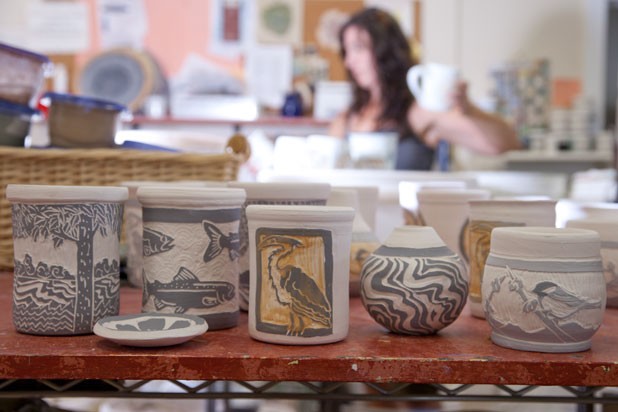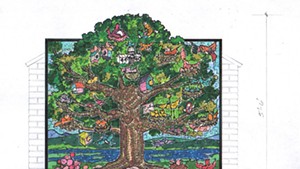
- Matthew Thorsen
- Shannon Morrison pottery
Tucked in the picturesque landscape of Waterbury Center, the old Green Mountain Seminary building perches magisterially on a hill. A set of neat steps festooned with flowers marks the entry to the building’s first floor, where the Seminary Art Center occupies a sunny, high-ceilinged space. In the front, a small gallery stocked with ceramic wares shows the skill of the artists who work here. Tiny pots and broad bowls mingle on the wooden shelves, inviting visitors’ curious perusal or acquisition. Through a doorway, you can see a few pottery wheels, a pair of kilns, a maze of dusty drying racks, long counters punctuated by stools, and powdery-looking creations awaiting their turn in the kiln.
Mame McKee founded the art center in 1996 as School House Pottery in Moscow, Vt. She moved the center to its current location in 2007. In the wake of Tropical Storm Irene, Seminary Art Center is one of a number of Waterbury organizations and businesses using art to help the town recover. Along with holding regular classes for children and adults, the facility is launching a mural project to meld its educational goals with the town recovery effort.
This summer, Seminary Art Center will host art camps for kids to design and paint two murals for downtown Waterbury. The center is offering 16 full scholarships, a boon for residents grappling with the demands and costs of Irene recovery.
The art lesson of designing and painting a mural doubles as a civics lesson, says Vermont artist and Seminary instructor Natasha Bogar. “Another purpose of this mural project is to connect multiple organizations within Waterbury with a common goal of improving our town,” she says. Besides SAC, the list of participating groups includes Waterbury Activities and Cultural Center, Waterbury Parks and Recreation, Waterbury Historical Society and Revitalizing Waterbury — all organizations Bogar hopes kids will get to know and appreciate through the project. “Youth learn from these civic groups what it means to be involved with community and making a positive difference,” she writes in an email.
On Sunday, July 8, Waterbury residents can work on two Irene-recovery art projects at a pair of sites. On Randall Street, one of the areas of town hit hardest by the flood, participants can translate their personal experiences of Irene into art with help from local artist and community activist Sarah-Lee Terrat and Thatcher Brook Primary School art teacher MK Monley. Their project, called “Floodgates,” provides kits that include a 6-by-6-inch panel, which participants can embellish in any way they choose. Eventually, the tiles will be attached to wire-mesh fencing and exhibited.
Terrat was inspired to create the project by her memory of a wall in downtown New York City that became a makeshift information center and commemoration after 9/11 as people posted images of missing loved ones, personal stories and mementos, images and texts. “Floodgates,” similarly, is both a forum for Irene experiences and a means of spiritual recovery from the trauma.
“I think people are tired,” Terrat says. “People have been through a lot. Not just the flood itself, but the trauma afterwards. The financial trauma and the displacement.”
Terrat and Monley hope to bring the community together around art. “There are a lot of positive stories that came out of [the storm],” Terrat says. “People have new heroes — people who helped them out or took them in in the moment, and also people who helped with the long-term effort. It’s a kind of therapy but also a way of giving thanks and a different way of telling your story.”
A few blocks away, community members can make their mark with another art project. When Irene hit, a state-of-the-art forensics lab was just coming online in Waterbury, reflecting a comprehensive plan developed by artist Dan Gottsegen and landscape architect Terrence Boyle through the Art in State Buildings Public Art program. After Irene, Gottsegen saw the need to amend those plans, adding a walkway lined with bricks inscribed by Waterbury residents.
“The brick idea bloomed because I wanted some commemoration of Irene for the community in the piece,” Gottsegen writes in an email. On July 8, participants can enhance hundreds of unbaked bricks donated by the Vermont Brick Company. After they’re inscribed, the bricks will be fired, then installed along the curving pathways through the grounds of the lab. “I hope it will be a nice addition to the piece, and give the community a sense of ‘ownership,’” writes Gottsegen. “When an idea has traction, there is a way that it evolves collaboratively. No one person has ownership of it. So I am quite excited about this.”
SAC may be a gem known only to locals, but Waterbury residents themselves seem to offer a wealth of creativity and community spirit. “[These projects are a] way to show that people who don’t consider themselves artists can become artists for projects, and that artists can and do become deeply involved in things going on around them,” Terrat says. “So we’re crossing over from being artists ... into being community activists, and it’s helping people who don’t consider themselves to be artists to be poets or painters for a day and see how they can use this medium.”
This summer, Waterbury residents have ample opportunity to demonstrate both their artistic talents and their community spirit.










Comments
Comments are closed.
From 2014-2020, Seven Days allowed readers to comment on all stories posted on our website. While we've appreciated the suggestions and insights, right now Seven Days is prioritizing our core mission — producing high-quality, responsible local journalism — over moderating online debates between readers.
To criticize, correct or praise our reporting, please send us a letter to the editor or send us a tip. We’ll check it out and report the results.
Online comments may return when we have better tech tools for managing them. Thanks for reading.